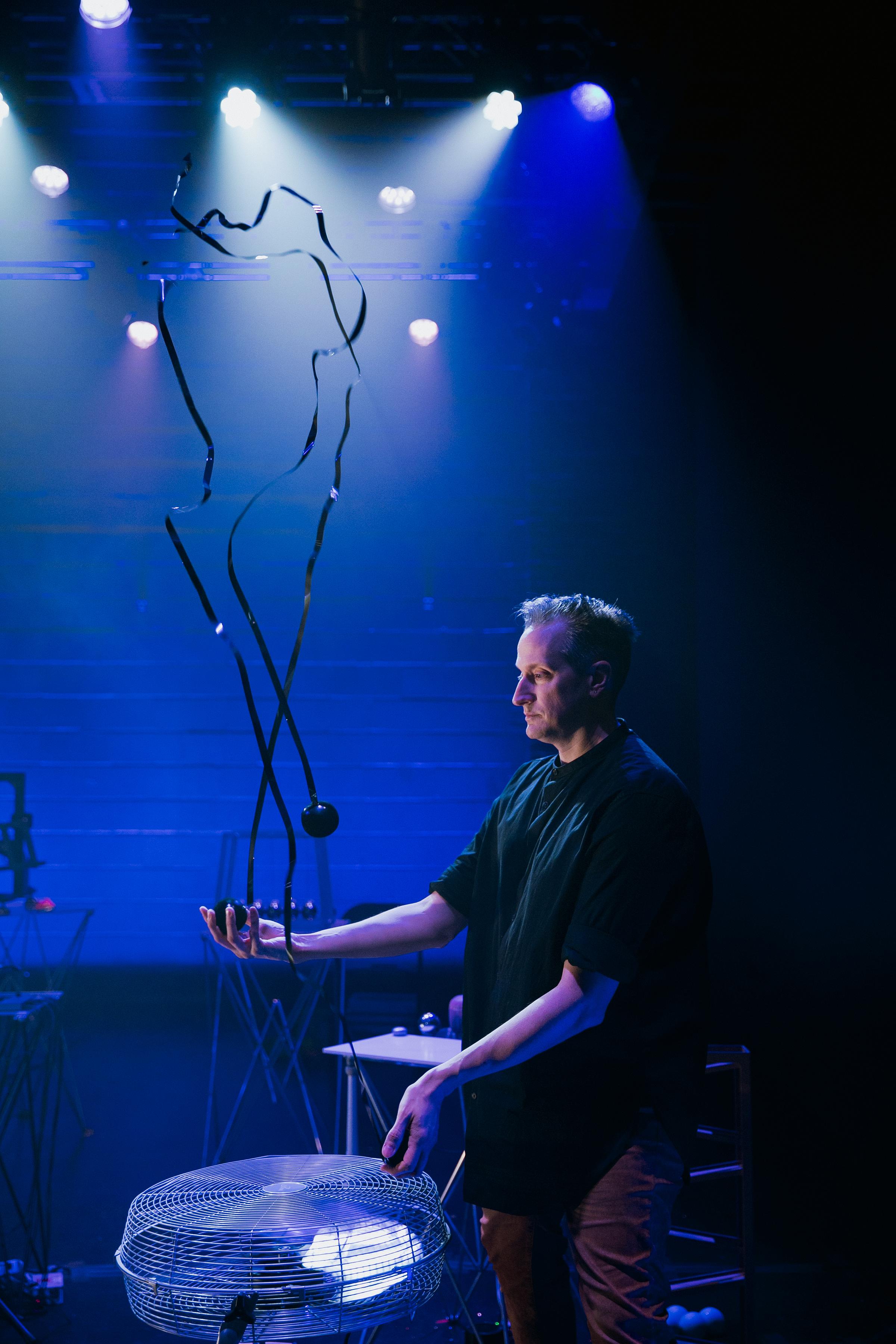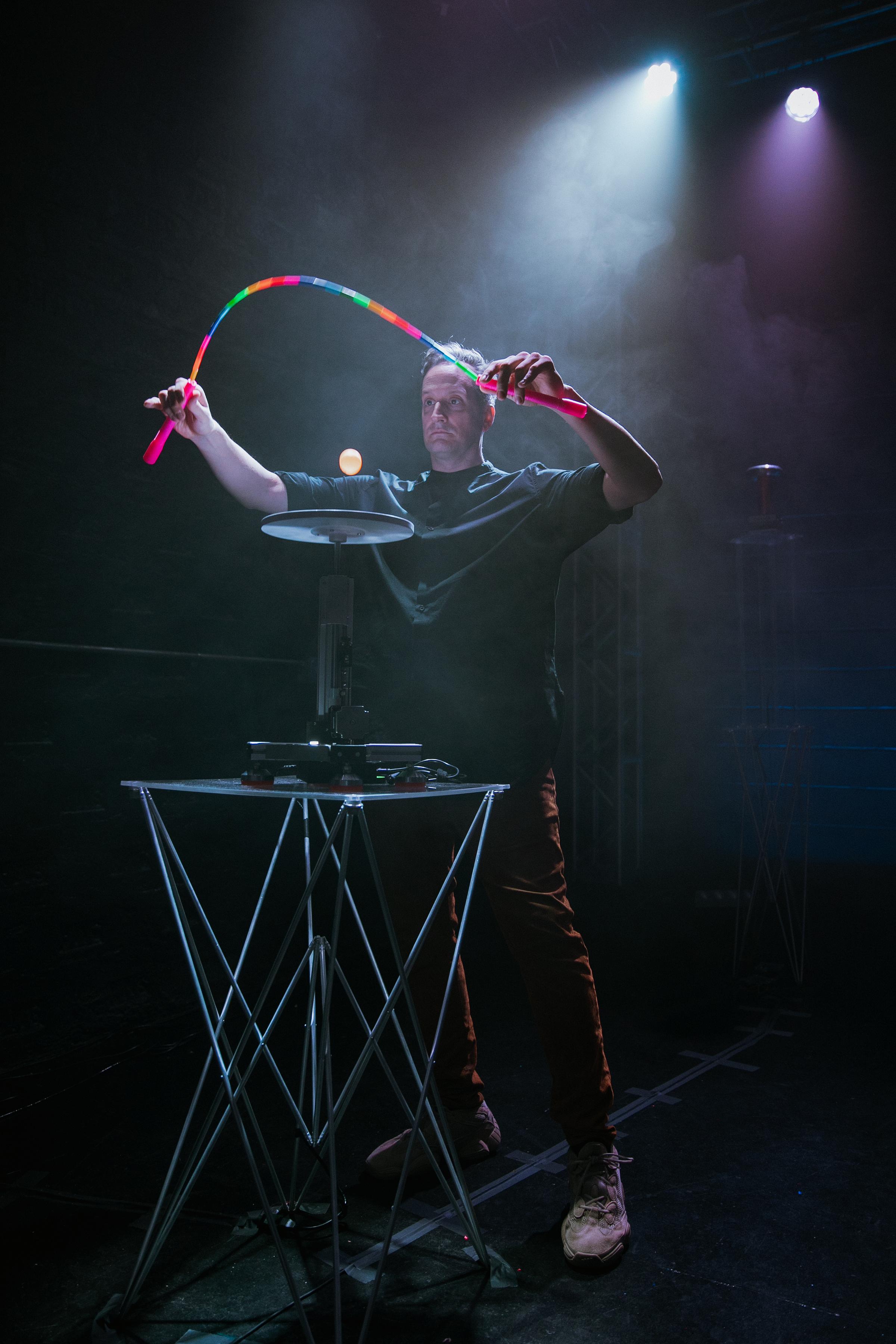REFLEX: Unraveling 4,000 Years of Juggling
Baruch Performing Arts Center
1 Bernard Baruch Way, NYC
Through Oct. 22, 2023
“Skill, difficulty, and risk,” juggler Jay Gilligan notes, are one set of metrics traditionally used to evaluate the quality of a juggling act. Ramping up the skill (like juggling faster or longer), difficulty (juggling more objects), or risk (juggling objects that are sharp, or set ablaze) involved in an act makes it more impressive. At least, that’s what’s commonly thought.
REFLEX — a juggling solo show performed by Gilligan, co-written by Gilligan and Frodo Santini, co-directed by Santini and Lyndsay Aviner, and produced by Hideaway Circus — boldly asks: What if excellence in juggling could come from being not only skillful, difficult, and risky, but also innovative, beautiful, and harmonious?

Part juggling act, part juggling lecture, and even part juggling concert, REFLEX is a unique experience that expanded my perception of what juggling can look and sound like.
At the top of the show I attended, a variety of juggling props (props design by Drew Aslesen), some conventional (juggling balls, clubs, and rings) and some not so much (an oscillating fan, a miniature industrial vacuum, a pair of jumbo Newton’s cradles) were neatly arranged across the stage, where they are visible throughout the entire show. Part of the fun of the REFLEX experience was seeing this motley crew of objects throughout the show and wondering, “Wow, when is he gonna juggle that?”
Here, and unlike in a magic act, as Gilligan dutifully informed us, there were no red herrings or misdirections to speak of. Every prop we see onstage did, satisfyingly, get utilized in at least one portion of the juggling performance.
While Gilligan could be seen warming up his juggling muscles onstage during the pre-show period with a few simple 3‑ball cascades, it took him a little bit longer to warm up as a performer in the more traditional sense. The first few minutes of the piece were a little dry and awkward at the performance I attended early in the run, as Gilligan contended with occupying the unique and difficult space of both juggler and actor at the same time.
Like every good juggler though, Gilligan did eventually catch everything he threw. An early segment wherein Gilligan gradually added balls to a cascade in response to audience prompting provided a well-timed opportunity to establish a stronger, more organic connection between performer and audience. Particularly helpful, in my opinion, was the enthusiastically vocal small child who always wanted an additional ball immediately, which garnered many laughs and smiles from both sides of the curtain.
After this segment, Gilligan seemed more connected with the audience, and comfortable juggling (pun intended) the various obligations a multimodal performance like REFLEX requires.

After proving early on that he was indeed skilled enough to juggle many balls at once, but also that one trick alone does not a 75-minute performance make, Gilligan veered into the fun, dazzling, and breathtaking realm of the more unique juggling tricks that were devised for the performance, which were where REFLEX really shone.
Weaving inventive juggling tricks with engaging commentary and history, each subsequent segment of the show brought something new and interesting to the performance. While juggling two balls and operating two newton cradles simultaneously, Gilligan discussed gravity, and argued that planetary orbits around our sun might be one of the grandest cosmic juggling acts we know.
After explaining that in the early history of juggling, jugglers would first brainstorm tricks and then construct props to execute those ideas, but in the age of mass prop production, the process has largely reversed, Gilligan returned to the roots of the art form. Gilligan had an idea: What if the objects he was catching in his hands had hands themselves, and could catch additional objects? The result was a pair of juggling clubs that were notched such that they could each catch a ball midair, so that Gilligan could catch the clubs, and the clubs could catch the balls, during a mesmerizing routine unlike any I’ve seen.
For me, the most exciting segment was one where Gilligan pushed the boundaries of the form by ingeniously demonstrating how juggling can become music, and the juggler, an instrument.
At one point in the performance, Gilligan stood behind what appeared to be some kind of sensor pad, and began to do a regular cascade. But then one of the balls dropped onto the pad.
At first I was perplexed, and thought he had made a mistake. But then, after bringing that ball back into the fold, he dropped another one on the pad, and then another. And after a brief delay, I realized that musical notes were playing through the speakers at the same rhythm he was letting the balls hit the pad, and that those sounds were looping. Then, as he changed objects and juggling rhythms, different instruments were being added onto the musical loop that played throughout the space, building up to a symphony of juggling-generated sounds. With the help of a little technical wizardry that is certainly beyond me, Gilligan composed music from scratch just by juggling. It blew my mind. It sounded pretty good, too.
As I prepared to attend REFLEX, I was curious to know how someone could possibly keep a juggling show entertaining and interesting for over an hour straight. Even something outlandishly extreme in the skill/difficulty/risk category would probably only capture my attention for so long. But to Gilligan and the team’s credit, I actually left the performance wanting more, and excited by the prospect of all the unexpected and delightful directions jugglers may take their craft in the future.
Maybe I don’t need to see someone juggle seven flaming chainsaws. Maybe.
Still Playing: REFLEX runs at the Baruch PAC until October 22, before touring around the US in November. Tickets are available here.
Up Next For Me: I’m having brunch at the Elm Street Diner in Stamford, Conn.






